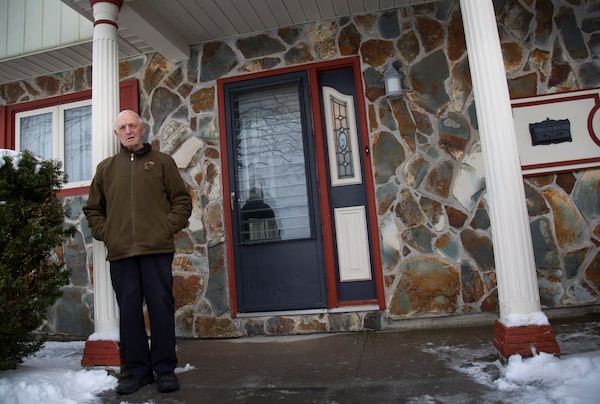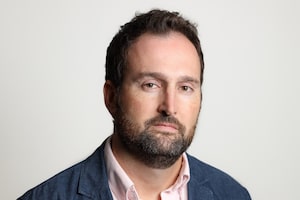
John Anderson, owner of Caul’s Funeral Home, seen here on the front step of his home in St. John’s on March 26, 2020, directed both of the funerals that are at the center of a coronavirus outbreak in Canada.Paul Daly/The Globe and Mail
Dealing with dying has been John Anderson’s specialty over more than 60 years in the funeral business. But until now, he never had to worry that the funerals themselves could be putting people’s lives at risk.
The long-time funeral director in St. John’s is stuck in self-isolation at home, waiting for the results of a COVID-19 test that was ordered by the province. His business is closed, and he and his wife are worried about their health.
“This virus is kind of like dying: You don’t think it’s going to happen to you, until it does,” he said over the phone. “No one was taking this thing seriously before. And that’s changed all the sudden.”
Caul’s Funeral Home, which Mr. Anderson runs with his son, has become a hot spot of the COVID-19 pandemic in Newfoundland and Labrador after at least 68 confirmed cases – out of 102 across the province as of Friday – were linked to two funerals there. Mr. Anderson directed both of them.
The outbreak has shaken Newfoundlanders and forced drastic changes to the rules around funerals. Overnight, funerals here, like everywhere else in Canada, have become sparsely attended events where hugging or touching is banned, where grieving family members must stand six feet apart and where surgical masks and gloves are as normal as wearing black.
It has also drawn more attention to infection clusters and the role they play in the contagion, after similar outbreaks at a curling bonspiel in Edmonton, where at least 11 health-care workers who played in the event were infected, and a dental conference in Vancouver, where more than 20 people contracted COVID-19.
At Caul’s Funeral Home, it’s believed the virus was spread by an infected person who had just returned from out of province and attended the funeral of a 78-year-old St. John’s man, Edward Tobin. His service and visitations overlapped with those of a 36-year-old woman, Shannon Fleming, over three days at the funeral home – March 15-17 – and the virus spread to people attending both events.
There were signs posted inside the funeral home reminding mourners to avoid touching each other, but people didn’t heed them, Mr. Anderson said. Caul’s also closed its lounge and banned outside food, he said.

At Caul’s Funeral Home, seen here on March 26, 2020, it’s believed the virus was spread by an infected person who had just returned from out of province and attended the funeral of a 78-year-old St. John’s man.Paul Daly/The Globe and Mail
Keeping mourners from hugging and consoling each other while they’re grieving a loved one is not an easy task, he said.
“Everything appears to be from that one person,” said Mr. Anderson, 79, who was tested Friday afternoon but said he was experiencing no symptoms. “We took all the precautions. We had signs up, telling them not to shake hands and all that. … This is just an unfortunate situation."
The funeral home is closed until April and is being disinfected while staff are being tested. When it reopens, funerals will look a lot different, with new restrictions limiting gatherings to 10 people. At the time of Mr. Tobin’s funeral, before a health emergency was declared in the province, as many as 50 people were allowed to gather in one place.
The ripples from that cluster at the funeral home have spread throughout the province. The Canada Post mail distribution centre in St. John’s has since been closed, its nearly 300 employees sent home, after 13 postal staff attended Mr. Tobin’s funeral and one tested positive for COVID-19.
The pastor who presided over the funeral is also in self-isolation, as are several paramedics who treated people who became ill after visiting the funeral home. It’s believed they may have also spread the virus to local hospital staff, who have been sent home for self-isolation.
“Of the people who have been affected in the St. John’s area, 75 per cent of them have come from one particular location,” said John Haggie, the province’s Health Minister. “One of the fallouts from that has been health-care workers who have contracted the virus at that location, and there has been some concern some of this may have also impacted their co-workers."
Of the province’s 102 cases, only one has been hospitalized. There have been no reported deaths, but the per-capita infection rate is now among the worst in the country, with 20 more cases since Thursday.
The U.S. Centers for Disease Control and Prevention says COVID-19 is most contagious when someone is showing symptoms and that it spreads mainly from person to person, when people are in close contact, but it can also be spread via surfaces.
The funeral cluster has prompted a lot of finger-pointing within the province. One infectious disease expert in Newfoundland said he didn’t want to comment because he was worried it would only fuel more discrimination against those who may have unknowingly spread the virus. Family members who attended both funerals also declined to speak publicly about the situation.
“It’s rattled the entire province," said Bert Twyne, the registrar of the province’s Embalmers and Funeral Directors Board.
The pandemic means Canadians are suddenly being separated from loved ones at the end of their lives, forcing funeral homes across the country to adapt, Mr. Twyne said. Some directors are live streaming burials; others are projecting closed-casket funerals on outdoor screens so people can watch from the safety of their cars.
With a maximum of 10 people per gathering, families are having difficult conversations about who can attend. Others are opting for cremation and delaying funerals until the pandemic ends – when hugging and touching will be allowed again.
It’s heartbreaking to watch families go through this, Mr. Twyne said.
“If you’ve got a loved one in a seniors’ home, you can’t see them. If they get sick and go to the hospital, you can’t see them. If they go to palliative care, you can’t see them. If they die and have a funeral, only a few people can get to see them.”
Mr. Anderson has directed thousands of funerals in his lifetime. He’s helped send off children and mothers, sons and fathers, people who have died all manner of deaths, in tragedies big and small. When the Ocean Ranger oil rig sank off Newfoundland’s coast in 1982 in a winter storm, killing all 84 crew members, he oversaw many of those funerals, too.
But as he sits at home, waiting for the phone to ring with the test results, he says he’s never experienced anything like this before. And he hopes it has awoken everyone to just how serious this pandemic has become.
“Now everybody is paying attention, of course. This whole city has turned into a ghost town,” he said. “If people weren’t awake before, they sure are now."
The spread of the novel coronavirus that causes COVID-19 continues, with more cases diagnosed in Canada. The Globe offers the dos and don'ts to help slow or stop the spread of the virus in your community.
The Globe and Mail
Sign up for the Coronavirus Update newsletter to read the day’s essential coronavirus news, features and explainers written by Globe reporters.
 Greg Mercer
Greg Mercer